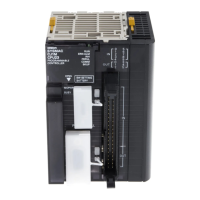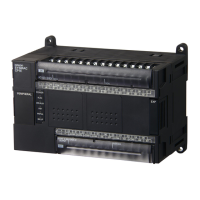PART 1: CX-Programmer
CHAPTER 2 – Quick Start Guide OMRON
CX-Programmer _Page 24
Use the following procedure to examine the ladder program.
1, 2, 3…
1. Ensure the Ladder program is displayed in the Diagram Workspace.
2. Switch to symbol table by selecting the View Local Symbols button from the toolbar.
Open the Address Reference Tool by selecting the Show Address Reference Tool button
from the toolbar.
3. Examine each symbol’s usage in the program by selecting a symbol whilst displaying the
Address Reference Tool, or moving around the diagram with the cursor.
The Ladder Program can also be viewed and edited in Mnemonics view. Block Programs can be entered in
either Mnemonics view or by showing a rung in statement list within the ladder editor.
Select the View Mnemonics button from the toolbar to display the Mnemonics view. To enter
mnemonics directly into the ladder editor, select Show as Statement List for the relevant
rung.
Compiling the Program
The program undergoes continual verification during its creation and any subsequent editing; this applies to both
on-line and offline programming. Errors appear in red in the ladder diagram. If a rung contains an error, a red
line appears down the left-hand side of the Ladder rung. This can happen, for example, when the element has
been placed on the diagram window but has not been assigned a symbol or address.
Use the following procedure to compile the program.
1, 2, 3…
1. To list any errors in the program, select the Compile Program button from the toolbar.
The output (for example, compilation progress or error details) is displayed in the Compile
tab of the Output Window.
Downloading the Program to a PLC
The project contains details of the type and model of the PLC for which the program is intended. Before a
program can be downloaded, this information should be reviewed to ensure that it is correct and that it matches
the PLC actually being used. The appropriate communications interface type should also be selected for the
connected PLC. Other parameters, for example PLC Setup may need to be specified before connecting to the
PLC and running a program. Refer to Chapter 4 - Reference and to the CX-Server PLC Tools User Manual
concerning the definition of the project’s IO Table, PLC Settings, Memory Card and Error Log.
Use the following procedure to transfer the program to the PLC.
1, 2, 3…
1. Save the current project by selecting the Save Project button from the toolbar. If the
project has not been saved before, the Save CX-Programmer File dialog is displayed.
Enter a file name in the File name field and select the Save pushbutton to complete the
save operation.
2. Connect to the PLC by selecting the Work On-line button from the toolbar. A
confirmation dialog is displayed: select the Yes pushbutton to connect. Since ordinary
editing is not allowed when on-line, the program becomes grayed.
3. Select the program object in the project workspace.
4. Set the PLC operating mode to Program by selecting the Program Mode button from the
toolbar. If this step is ignored, CX-Programmer automatically places the PLC in this
mode.
5. Select the Download button from the toolbar. The Download Options dialog is displayed.
6. Set the Programs field and select the OK pushbutton.
Programs can be downloaded to CS/CJ-series CPU Unit Ver. 2.0 or later, and downloading by task (program)
instead of the whole user program is possible (CX-Programmer Ver. 4.0 or later). Select Partial Transfer –
Task Transfer to PLC from the PLC Menu, and download a specified single task or multiple tasks. This
function enhances the efficiency of program development by multiple personnel. Particularly, by downloading
to the PLC by task (program), only the parts to be changed are reflected in the PLC, resulting in fewer working
errors.
